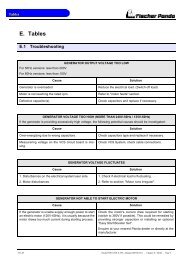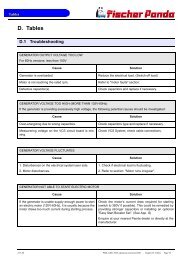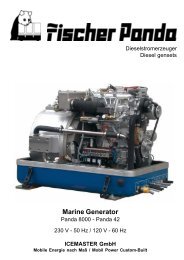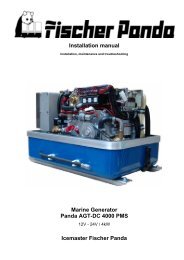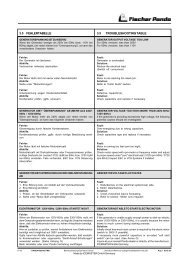Marine Generator Panda PMS 8 âminiâ E-TEC Icemaster Fischer ...
Marine Generator Panda PMS 8 âminiâ E-TEC Icemaster Fischer ...
Marine Generator Panda PMS 8 âminiâ E-TEC Icemaster Fischer ...
You also want an ePaper? Increase the reach of your titles
YUMPU automatically turns print PDFs into web optimized ePapers that Google loves.
<strong>Generator</strong> Failure<br />
Overloading the <strong>Generator</strong> with Electric Motors<br />
With the operation of electric motors it must be considered that these take up a multiple of their<br />
rated output as starting current (six to tenfold).<br />
If the power of the generator for the engine is not sufficient, the voltage in the generator breaks<br />
down after switching on the engine. For special approach problems the manufacturer can give<br />
recommendations regarding the accomplishment of the situation (e.g. amplified capacitors, gradual<br />
start switch or extra developed starting unit for electric motors).<br />
The system efficiency can be improved up to 50% and the starting current can be improved up to<br />
100% by a professional adjustment of the engines. If the inductive load (electrical motors etc.)<br />
lies over 20% of the generator rated output a compensation is appropriate (see in addition also<br />
the writing: "Operation Instructions for <strong>Generator</strong>s with Inductive Loads").<br />
C.2.1 Monitoring the <strong>Generator</strong> Voltage<br />
ATTENTION! - see “Safety Instructions” on Page iv.<br />
The voltage range of the power stations normally lies between 200 and 240V (100 - 130V in the<br />
60Hz version). In some countries even substantially larger tension deviations are being called<br />
"normally". The PANDA generators are aligned that they keep these default values during normal<br />
load.<br />
With high load or overload it can occur that the voltage drops on 190V (95V in the 60Hz version)<br />
and partly still more deeply. That can become critical for certain devices (e.g. for electric motors,<br />
cooling compressors and possibly for electronic devices). It must be paid attention that the<br />
voltage for such load is sufficient. This can be supervised by a voltmeter.<br />
The voltmeter should be always installed behind the change over switch generator/land power,<br />
so that each voltage source is shown. No further voltmeter is provided for the generator itself.<br />
If additional load is switched on, the voltage must be controlled in each case at the voltmeter.<br />
Sensitive devices must be switched off so long, until the voltage exceed the critical parameter.<br />
Under certain circumstances the generator provides overvoltage. This arises if the number of<br />
revolutions of the generator is increased. Changing the number of revolutions may be made only<br />
with a tachometer and/or a voltmeter.<br />
If sensitive and/or valuable devices are used, which are to be protected against this risk, an automatic<br />
overvoltage protection must be mounted. (voltage control with disconnection).<br />
C.2.2 Automatic Voltage Monitoring and Auto-Shut Down<br />
If air conditioning units (compressors) or other such valuable equipment is installed on-board, it is<br />
recommend that an automatic voltage monitoring unit be installed to protect this equipment from<br />
possible sharp voltage drops. The voltage monitoring system shuts down the entire system (and<br />
therefore all users) by means of a circuit breaker relay as soon as the voltage falls below a set<br />
value (the monitor will also shut down the on-board grid automatically when the generator is stopped).<br />
Such a relay with contactor can be obtained from the installator or as a complete unit from<br />
your <strong>Panda</strong> dealer.<br />
Page 32<br />
<strong>Panda</strong> <strong>PMS</strong> 8 "mini" E-<strong>TEC</strong> s00585 - Chapter C: <strong>Generator</strong> Failure



